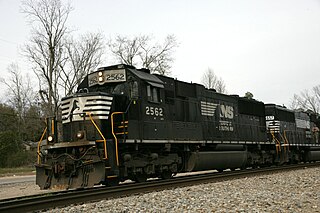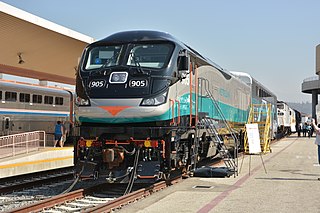
GE Transportation is a division of Wabtec. It was known as GE Rail and owned by General Electric until sold to Wabtec on February 25, 2019. The organization manufactures equipment for the railroad, marine, mining, drilling and energy generation industries. The company was founded in 1907. It is headquartered in Pittsburgh, Pennsylvania, while its main manufacturing facility is located in Erie, Pennsylvania. Locomotives are assembled at the Erie plant, while engine manufacturing takes place in Grove City, Pennsylvania. In May 2011, the company announced plans to build a second locomotive factory in Fort Worth, Texas, which opened in January 2013.

The EMD E5 is a 2,000-horsepower (1,500 kW), A1A-A1A passenger train-hauling diesel locomotive manufactured by Electro-Motive Corporation, and its corporate successor, General Motors' Electro-Motive Division (EMD) of La Grange, Illinois, and produced exclusively for the Chicago, Burlington and Quincy Railroad, and its subsidiaries, during 1940 and 1941. The E5 was distinguished from the otherwise very similar E3, E4 and E6 by being clad in polished stainless steel to match the Burlington's Zephyr trains. It also featured unique small grill-like ornamentation on both sides of the upper headlight. Like the other pre-war models in the E-series, the E5 had a sloping “slant nose” and it was equipped with two headlights — a regular stationary headlight above a gyrating Mars signal light. The E5 was the sixth in the EMD E-unit series.

The EMD F40PH is a four-axle 3,000–3,200 hp (2.2–2.4 MW) B-B diesel-electric locomotive built by General Motors Electro-Motive Division in several variants from 1975 to 1992. Intended for use on Amtrak's short-haul passenger routes, it became the backbone of Amtrak's diesel fleet after the failure of the EMD SDP40F. The F40PH also found widespread use on commuter railroads in the United States and with VIA Rail in Canada. Additional F40PH variants were manufactured by Morrison-Knudsen and MotivePower between 1988 and 1998, mostly rebuilt from older locomotives.

General Motors Diesel was a railway diesel locomotive manufacturer located in London, Ontario, Canada. It was established in 1949 as the Canadian subsidiary of the Electro-Motive Diesel division of General Motors (EMD). In 1969 it was re-organized as the "Diesel Division of General Motors of Canada, Ltd." The plant was re-purposed to include manufacture of other diesel-powered General Motors vehicles such as buses. Following the Canada-United States Free Trade Agreement in 1989, all of EMD's locomotives were built at the London facility. In 2005 new owners of EMD renamed the Canadian subsidiary "Electro-Motive Canada". The plant was closed by EMD's new owner Progress Rail in 2012, with EMD's production remaining in LaGrange, Illinois and Muncie, Indiana.

The EMD SD70 is a series of diesel-electric locomotives produced by the US company Electro-Motive Diesel. This locomotive family is an extension and improvisation to the EMD SD60 series. Production commenced in late 1992 and since then over 5,700 units have been produced; most of these are the SD70M, SD70MAC, and SD70ACe models. While the majority of the production was ordered for use in North America, various models of the series have been used worldwide. All locomotives of this series are hood units with C-C trucks, except the SD70ACe-P4 and SD70MACH which have a B1-1B wheel configuration, and the SD70ACe-BB, which has a B+B-B+B wheel arrangement.

The EMD SD90MAC is a model of 6,000 hp (4,470 kW) C-C diesel-electric locomotive produced by General Motors Electro-Motive Division (EMD). It is, with the SD80MAC, one of the largest single-engined locomotives produced by EMD, surpassed only by the dual-engined DDA40X.

Electro-Motive Diesel is a brand of diesel-electric locomotives, locomotive products and diesel engines for the rail industry. Formerly a division of General Motors, EMD has been owned by Progress Rail since 2010. Electro-Motive Diesel traces its roots to the Electro-Motive Engineering Corporation, founded in 1922 and purchased by General Motors in 1930. After purchase by GM, the company was known as GM's Electro-Motive Division. In 2005, GM sold EMD to Greenbriar Equity Group and Berkshire Partners, and in 2010, EMD was sold to Progress Rail. Upon the 2005 sale, the company was renamed to Electro-Motive Diesel.

The EMD MP15T is a model of diesel-electric switcher locomotives built by General Motors Electro-Motive Division between October 1984 and November 1987. Instead of a non-turbocharged 12-cylinder EMD 645 engine it uses a turbocharged 8-cylinder engine. The external appearance of the engine remains similar to other MP15 models.

The EMD Model 40 was a two-axle diesel-electric switcher locomotive built by Electro-Motive Corporation (EMC), and its corporate successor, General Motors' Electro-Motive Division (EMD) between August 1940 and April 1943. Nicknamed "critters", eleven examples of this locomotive were built. Powered by twin General Motors Detroit Diesel 6-71 diesel engines, which produce a combined 300 horsepower (224 kW), its drivetrain is unusual because the two diesel engines are used to drive the electric DC generator from both sides, one with clockwise rotation and the other with counter-clockwise rotation.

The Electro-Motive Diesel (EMD) Class 66 are Co-Co diesel locomotives built by EMD for the European heavy freight market. Designed for use in Great Britain as the British Rail Class 66, a development of the Class 59, they have been adapted and certified for use in other European countries. Outside Europe, 40 locomotives have been sold to Egyptian Railways for passenger operation.
The MK5000C is a 5,000 hp (3.7 MW) North American diesel-electric locomotive developed by MK Rail. At the time of its introduction in 1994, the MK5000C was the most powerful single prime mover diesel-electric locomotive ever made, a title it would hold for only for one year until GE Transportation released its competing 6,000 hp (4.5 MW) AC6000CW model in 1995.

The Stadler Euro is a class of diesel-electric locomotives built by Stadler Rail for the European market. It is available in two basic variants, the four-axle Euro 3000, and the six-axle Euro 4000. These locomotives are powered by EMD 710 prime movers. A six-axle electric-only variant is marketed as Euro 6000; it is also built for the Iberian gauge.
Stadler Rail Valencia SAU is a Spanish company, mainly producing products for the railway industry, subsidiary of Stadler Rail.

The EMD G22CU is a metre gauge diesel-electric locomotive designed and built by the Electro-Motive Division of General Motors. It was manufactured by several licensees, and exported to many countries including Argentina, Australia, Brazil, Egypt, Iran, New Zealand, Nigeria, Pakistan, South Korea, Yugoslavia and Taiwan (ROC).

The South African Railways Class 35-200 of 1974 is a diesel-electric locomotive.

The South African Railways Class 37-000 of 1981 is a mainline diesel-electric locomotive.

The EMD F125 "Spirit" is a four-axle passenger diesel locomotive manufactured by Electro-Motive Diesel (EMD) for the North American market since 2015. It is powered by a Caterpillar C175-20 V20 diesel engine rated at 4,700 hp (3,500 kW). The locomotive is capable of traveling at a maximum in-service speed of 125 mph (201 km/h) pulling consists of up to 10 cars. It was EMD's first new passenger locomotive for the North American market in 15 years, with the most recent predecessor passenger locomotive being the EMD DE30AC and DM30AC built for the Long Island Rail Road. So far, Metrolink is the only customer of the F125.
The EMD 1010 or EMD 265 is a line of four-stroke diesel engines manufactured by Electro-Motive Diesel. The precursor to the 1010 was introduced around 1998 as the 265H or H-Engine. The H-engine was initially designed for use as a 6,300 hp (4,700 kW) 16 cylinder, the EMD SD90MAC; however, the early engines were found to be unreliable, and unsuccessful in the market, with the proven EMD 710 2-stroke design being preferred. The EMD four-stroke engine was resurrected in 2015 to meet EPA Tier 4 emissions regulations.


















